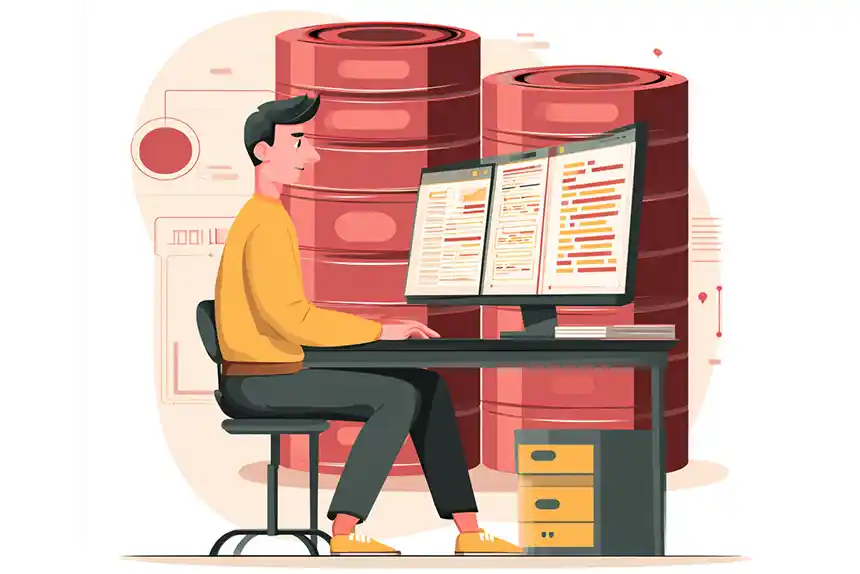Decoupled CMS: Understanding Headless vs Decoupled Architecture

Amanda Lee

Enterprises looking for a content management system to manage their website and other digital experiences will likely encounter several options described by various marketing terms during their research, from traditional or legacy CMSs like Drupal and Adobe AEM, to headless CMSs, composable CMSs, digital experience platforms (DXPs), and a host of other terms in between.
One of these terms is the "decoupled CMS". When talking about headless CMSs in particular, decoupled CMS and headless CMS are often used interchangeably. Unfortunately, this isn’t entirely accurate.
In this blog post, we’ll help you avoid confusion by explaining what a decoupled CMS really is, the ins and outs of a decoupled CMS architecture, and the benefits and drawbacks of the decoupled approach.
What Is a Decoupled CMS?
A decoupled CMS is a content management system that separates content authoring and content delivery and places them in separate applications and often in separate infrastructure. These two applications are connected via APIs.
But isn’t that headless? Not quite.
A headless CMS delivers content to the frontend presentation layer as a service, typically using REST APIs or GraphQL. The benefit of this architecture is that content is created and published once but can be requested and uniquely displayed by various channels or devices, providing flexibility to the frontend developer and technology.
While headless CMS architectures decouple content from the presentation, they do not inherently dictate the CMS’s authoring or delivery coupling or separation.
The Two Levels of Decoupled Architecture
Essentially, there are two levels of decoupled architecture: simple headless (frontend) decoupling and advanced, enteprise decoupling of the content authoring and content delivery systems.
Simple Headless Decoupling
Simple headless decoupling involves the separation of the backend (content editing, storage, management, publishing) and the frontend (end user UI) of the CMS.
All headless CMSs decouple the backend from the frontend (that's the whole point of "headless"), but many headless CMS vendors claim to be decoupled, but in reality, they often are not. The defining feature of a headless CMS is its use of APIs to connect to various front-end layers. However, many headless CMS vendors still tightly couple their authoring capabilities with the headless delivery system.
Enterprise Decoupling
True enterprise-grade decoupling involves separating not only the frontend UI from the backend content, but also the content authoring system and content delivery systems of the CMS. Unlike headless CMSs that claim to be decoupled, a truly enterprise-decoupled CMS has separate authoring and delivery instances, keeping them distinct.
CrafterCMS is an example of a headless CMS offering this enteprise decoupled architecture -- separating both the UI from the backend via APIs, AND separating the content authoring system from the content delivery system, as shown in Figure 1 below.

Figure 1. Enteprise Decoupled CMS Architecture
Benefits of an Enterprise Decoupled CMS
When IT architects opt for an enterprise decoupled CMS, they can realize a number of benefits.
- Performance: They can deploy the authoring and delivery systems separately and tailor them for high performance - the authoring system scaled and located based on the content authoring team's needs, and the delivery system provisioned and located based on the site/app visitor locations, traffic consumption, and more.
- Scalability: With a decoupled CMS, users can scale for high-traffic websites without extensive modifications and scale only the necessary components. If there are no additional authors, there’s no need to expand the authoring infrastructure, reducing complexity and potential license costs.
- Multitenancy: Easily manage multiple sites, apps and delivery channels.
- Very High Security: Since authoring and delivery are completely decoupled from each other, this offers additional security benefits as users (or hackers) of the content delivery system and its frontend apps/sites have no physical connection to the internal content authoring system.
- Cost Effectiveness: As the authoring and delivery systems can be tailored for just exactly what each system needs to deliver, there is no waste of resources and costs when compared to monolithic, coupled CMS architectures.
Potential Drawbacks of Decoupled CMS
However, while an enterprise-grade decoupled CMS offers several benefits, some drawbacks exist.
- Deployment Complexity: In a decoupled CMS, deployment is more involved as underlying infrastructure and configuration is needed for both the authoring and delivery systems.
- Potential Publishing Delays: The publishing process may be slightly longer and may involve more points of failure.
- Low Level Granularity: Too much granularity of system components can increase complexity and reduce the cohesion for simpler use cases.
As a result, truly decoupled CMSs are best suited for mid- to large-size enterprises (and fast scaling startups) that benefit from the additional performance, scalability, security, and cost effectiveness that are inherent in this architecture.
Decoupled CMS Use Cases
Some ideal use cases for an enteprise decoupled CMS include:
Global Websites
A decoupled CMS is perfect for large global organizations with websites in multiple regions and countries. This provides extra layers of security and enables organizations to have authors in one or more countries or regions and audiences across many regions. This way, they can put the authoring systems closer to the authors and delivery closer to where all the site/app visitors are located.
Highly Secure Industries
Finance, government, and healthcare organizations (to name just a few) that require a high level of security can benefit from the inherently secrue decoupled CMS architecture to build their customer portals, websites, mobile apps, and more.
E-Commerce and Media Companies
E-Commerce businesses and media companies that need always-on performance can leverage the performance and security benefits of a decoupled CMS. It provides elastic scalability for media spikes, news or promotional events, and major seasonal moments such as Black Friday.
Large-scale Intranets and Extranets
Global organizations can have HR teams in one location while employees and associates are worldwide. Meanwhile, content can be managed centrally at headquarters.
OTT Video Experiences
Rich media experiences such as OTT video streaming (live and VOD) benefit from the high-performance content delivery system of a decoupled CMS.
CrafterCMS: The Enteprise Decoupled Headless CMS
CrafterCMS is a truly enterprise decoupled headless CMS that offers unique capabilities, highlighting why advanced decoupling can provide the security, performance, and scalability benefits that surpass other headless CMSs that only decouple the frontend UI from the backend CMS (which of course CrafterCMS also supports as a headless CMS).
Separation of Content Authoring and Content Delivery
By definition, a decoupled CMS separates the content authoring system from the content delivery system. This allows organizations to manage their scaling since more people will consume content than the number of users authoring/editing/publishing it.
With CrafterCMS, enterprises get all the performance, security, scalability and cost benefits as the content authoring system and app (Crafter Studio) is completely decoupled from the API-first headless content delivery system (Crafter Engine).
Global Delivery
The primary challenge for decoupled CMSs is ensuring consistency across globally distributed content. In multinational organizations using traditional CMS instances on various servers worldwide, it’s hard to keep database-driven CMS's in sync, and its also common for these database-driven content stores to fall out of sync.
Git-based CMS
CrafterCMS is a Git-based CMS that stores all content in files inside its Git-based content repository. Git is responsible for all content versioning, auditing, branching and such. There is complex database management and syncing involved, which contrasts with other legacy decoupled systems such as Adobe AEM and Magnolia DXP, which manage content using a database rather than Git.
No Database Syncing
In a traditional database-driven CMS, the authoring and delivery systems directly share a database to deliver content. CrafterCMS does not have a shared database between the authoring and delivery tiers. Instead, authored content is stored in industry-standard file formats in Git, and published to the delivery tier (onto disk and/or bucket storage). This stateless and serverless approach removes the scalability constraints typically imposed by databases on the CMS delivery tier.
Multi-tenant CMS
CrafterCMS offers multi-tenancy, which allows enterprises to manage multiple sites and apps via numerous independent CMS projects, all on the same infrastructure. They can assign specific sites/apps to different groups of users, limiting user access to only those sites within their scope of responsibility.
Marketer Friendliness
CrafterCMS's content authoring system and user application (Crafter Studio) is built for marketers and other content authors/editors/creators. The decoupling of Crafter Studio from Crafter Engine provides architectural flexibility, and content authors benefit from drag/drop experience building, WYSIWYG in-context content editing, multi-channel previews, and many more user-friendly features.
Developer Freedom
With CrafterCMS's API-first headless content delivery system (Crafter Engine), developers have the freedom and flexibility to use any front-end UI technology, including React, Vue, Angular or Freemarker (for HTML templating), have access to a rich set of REST and GraphQL APIs, and even are able to extend the backend with Groovy scripting or JavaScript frameworks like Node.js or Next.js.
Elastic Scalability
CrafterCMS’s elastic scalability allows enterprises to handle traffic demands without impacting performance. This guarantees a smooth user experience even during peak periods.
DevContentOps
CrafterCMS introduces the concept of DevContentOps, which brings content management processes and the CMS tool into the DevOps approach. Content, development, and operations teams can collaborate seamlessly to publish content updates, release new software features, and provide engaging experiences without the traditional delays or bottlenecks of other CMSs.
Learn more about what a truly decoupled CMS can accomplish by watching our webinar: Introducing CrafterCMS v4.0.
Related Posts

Publishing Content from Crafter Studio to External Systems and Databases

Sara Williams

Websites Are Dead?

Mike Vertal

No-Code Experience Building for Marketers & Designers

Amanda Lee

Is Your CMS MACH-Ready? A Practical Guide for Enterprise Architects

Sara Williams










